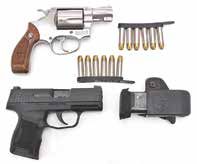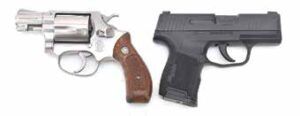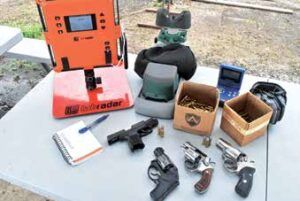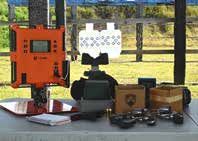Once widely maligned as “Tupperware,” the polymer pistol now rules the shooting world to the point where the writer of this article, who is also a very active trainer and LTC instructor, has many students say they’ve never shot an all-metal handgun. And some are also not personally familiar with the revolver, regardless of composition. So, our Houston testers wondered if the 38 Special wheelgun is practically dead, or can it still serve a useful purpose as a viable every-day carry handgun when so many good semi-automatic 9mm pistols exist.
To find out, we chose the SIG Sauer P365, perhaps the hottest-selling handgun in this country, as a benchmark against which to compare some new and not-so-new revolvers. The baseline we tested against was a SIG P365 365-9-BXR3 9mm Luger, $599. As a value proposition, we started off the revolver part of the tests with an older S&W Model 60 38 Special, $459. The closest modern equivalent of the 1978-version Model 60 is a blued Model 36 150184 38 Special, $809. Next, we included a Ruger LCR 5401 38 Special +P, $699. Last was a Ruger SP101 5737 38 Special, $859. Someday, the ammo drought will end, but because we’re not there yet we once again used properly assembled reloads for the revolvers. We tried to get a little extra speed with those short barrels, so we used 125-grain bullets. The first we tried was Hunter’s Supply hard-cast lead flat point from MidwayUSA.com (418579, $15/100). We also shot Hornady’s 125-grain XTP (490514, $24/100). For the SIG P365 9mm, we used SIG Sauer’s 115-grain V-Crown (MidwayUSA.com 966280, $22.50/20) and 9mm Remington Range ammo (542116, $30/50).
Keeping in the mind the assumed use of these handguns was for self defense, accuracy testing was done at 7 yards. Even though two of the three revolvers allowed single-action shooting, all testing for accuracy and speed was performed double action only. Group shooting consisted of multiple five-shot strings fired from a well-weighted Caldwell Pistolero shooting rest (MidwayUSA.com 562771, $30). Muzzle velocities were obtained via a LabRadar chronograph. All shooting was done at American Shooting Centers in west Houston. Here’s how the handguns performed.
Gun Tests Grade for SIG Sauer P365: A (OUR PICK)
$599
The SIG P365, both the standard 3.1-inch and its 3.7-inch XL Model big brother, have graced the pages of Gun Tests several times in the past (see the January, February, and March 2020 editions). They performed well for us receiving, at worst, a B grade. The shooting public seems to agree with us, because several of our sources cite this little pistol as the No. 1-selling handgun in the country as of this writing.
| Action Type | Semi auto, tilt action |
| Overall Length | 5.75 in. |
| Overall Height | 4.1 in. |
| Maximum Width | 0.985 in. |
| Weight Unloaded | 1.0 lbs. |
| Weight Loaded | 1.4 lbs. |
| Slide Material | Stainless steel |
| Slide Retraction Effort | 13.8 lbs. |
| Receiver Material | Polymer |
| Finish | Nitron |
| Front Strap Height | 1.8 in. |
| Back Strap Height | 2.4 in. |
| Barrel Length | 3.1 in. |
| Grip Thickness (Maximum) | 0.985 in. |
| Grip Circumference | 4.8 in. |
| Magazine Capacity | 10, 12, or 15 rounds |
| Rear Sight | Drift adjustable with tritium insert |
| Front Sight | Drift adjustable with tritium insert |
| Trigger Pull Weight | 5.1 lbs. |
| Trigger Span | 2.7 in. |
| Safety | Firing pin block |
| Warranty | Limited lifetime |
| Telephone | (603) 610-3000 |
| Website | SIGSauer.com |
| Made In | USA, NH |

For comparison to the 38 Special Range Data below, our P365 chronographed at around 1072 fps using SIG V-Crown 115-grain JHPs that have been optimized for short-barreled pistols. Energy with that load was 293 foot-pounds, and groups averaged a mere 0.68 inch. That’s substantially more energy that the 38 Special rounds produced, and it was much more accurate, by a wide margin. The pistol also won the speed drills, as shown in the Drill Data table below. So just on ballistic performance compared to 38 Special-chambered revolvers, it’s easy to see why the SIG P365 has seen this kind of success.
But there are other reasons as well. For one, it is small enough to use for pocket carry. While this may not be our favorite method of everyday carry, we live on the Gulf Coast and it is hot here. Summer starts in mid-March and usually ends around the second week of deer season. To battle the heat, those who frequent the outdoors often find themselves armed with a small pistol in a small pocket holster, such as the DeSantis Nemesis (MidwayUSA.com, $20).
Another plus to the SIG pistol is its ammo capacity. SIG reportedly engineered the P365’s magazine first and then built the pistol around it. The pistol ships with a flush-fitting 10-round mag as well as an extended 12-round mag. Also, 15-rounders are available.

A third reason for the P365’s ascendency is the energy of a good 9mm. There are danged few shooting situations that can’t be solved with the round.
Elsewhere, the SIG Sauer P365 has good sights, a decent trigger and, while small, it is actually big enough to hold onto. All things considered, SIG’s P365 is a real winner, as sales figures confirm.
While we wanted to acknowledge the SIG P365, its great design, and the success it has had, it is not our intent to do a full review on a pistol we have already visited several times. Realistically, the Springfield Armory Hellcat, Smith & Wesson Shield, and several others could also have sufficed to see if they have totally and irrevocably supplanted a good snubnosed revolver for concealed carry.
Our Team Said: Small enough to fit in a pocket and carrying 10+1 rounds of 9mm, a small pistol such as the P365 does a lot right for comfortable concealed carry. Does a little 9mm snap in your hand a bit when fired? Of course. But felt recoil is less than the small 38s.
Bottom Line
In our tests, the SIG Sauer P365 shot more quickly, was a bit easier to shoot accurately, recoiled a bit less, concealed more easily, and carried a higher round count of somewhat more powerful ammunition. It would appear that we have destroyed our own argument about the viability of the snub-nosed revolver in the modern shooting world, except in the areas of dependability and simplicity of deployment. We believe those are important considerations. To wit:

Semi-automatic pistols are more likely to malfunction than revolvers. Making sure your Pocket 9 is well-maintained will mitigate a large percentage of potential problems. If it does jam, a little bit of training and a solid “Slap, Rack, Bang” will fix most of the things that can go wrong. With the revolver, however, simply pull the trigger again.
Semi-autos can be more sensitive to ammunition selection and fundamentals of grip and stance. Don’t lock the arms out, and the auto can malfunction. Feed it the wrong ammo, and it can malfunction. The revolver doesn’t care if you put five different kinds of old ammo in there. If it doesn’t work, press the trigger again. We have done many demos where we held the revolver upside down and activated the trigger with our little finger. We are less likely to be accurate, of course, but the revolver didn’t care.

Many law-enforcement officers carry a small revolver in an ankle holster. Yeah, ankle holsters are itchy and uncomfortable when you first wear them, but so are inside-the-waistband holsters. That ankle holster leaves the backup gun down close to the dirt. Do an informal survey sometime and ask police officers whether they are willing to trust their lives to a semi-auto or a revolver that is likely to get dirty. A quick note on the ankle holster for the average citizen — they work very well for someone who drives a lot. Puts that handgun in an accessible location.
Those with less-than-optimal hand strength may find the semi-auto slide hard to rack and the manual of arms more difficult to perform. The operating procedures on the revolver are simple and few — open the cylinder, load the cylinder, close the cylinder, press trigger. We readily acknowledge that those with diminished hand strength might also find issue with the longer, and frequently heavier, trigger pull required from the revolver.

What if you have the semi-auto in a purse or coat pocket with an absolute need to shoot and no time to draw? Press the trigger. In all likelihood, you will get one shot off before the slide fouls in the pocket and the gun malfunctions. The revolver doesn’t care. Press the trigger again as necessary.
If, heaven forbid, a good guy or gal has to defend themselves at contact distance, pushing the muzzle of a semi-auto into the attacker will force the slide to the rear, rendering the pistol inoperable until that condition is remedied. The revolver doesn’t care. Press the trigger again as necessary.
Is the small revolver the perfect everyday carry gun? No. The snubnosed 38 Special is a tool, a specialized tool, that does some jobs better than just about any other choice. Several of our test group carry Pocket Nines on a daily basis, especially during the summer in Houston. We have no intention of giving them up. But when it gets cold, we carry a 38 Special in a coat pocket because we don’t have time to dig through the other layers to get to the pistol on our belt.
When we carry a second handgun, we carry a 38 Special. When we drive a lot, we carry a 38 Special. We know tons of ladies who carry them in their purses and quite a few other folks that carry a 38 Special off body in a briefcase. We have no intention of trading in our snubbies, but we do realize their increasingly specialized role in concealed carry.
Drill Data (5x9x7)
| Pistol | Time to First Shot (seconds) | Split Average (seconds) | Total Time (seconds) |
|---|---|---|---|
| SIG Sauer P365 9mm Luger | 0.83 | 0.21 | 1.68 |
| S&W Model 60 38 Special | 0.9 | 0.28 | 2.03 |
| Ruger LCR 38 Special | 0.87 | 0.27 | 1.94 |
| Ruger SP101 38 Special | 0.87 | 0.28 | 1.98 |
38 Special Range Data
| Hunter’s Supply 125-grain Lead | S&W Model 60 | Ruger LCR | Ruger SP101 |
| Average Velocity | 792 fps | 790 fps | 820 fps |
| Muzzle Energy | 174 ft.-lbs. | 173 ft.-lbs. | 187 ft.-lbs. |
| Best Group | 1.32 in. | 1.79 in. | 1.38 in. |
| Average Group | 1.62 in. | 2.39 in. | 1.69 in. |
| Hornady 125-grain XTP | S&W Model 60 | Ruger LCR | Ruger SP101 |
| Average Velocity | 827 fps | 842 fps | 863 fps |
| Muzzle Energy | 190 ft.-lbs. | 197 ft.-lbs. | 207 ft.-lbs. |
| Best Group | 1.23 in. | 1.98 in. | 0.61 in. |
| Average Group | 1.34 in. | 2.33 in. | 1.16 in. |
Testing was done at American Shooting Centers in west Houston. Muzzle velocities were determined via a LabRadar chronograph ($559). All shots for group were fired double action from a well-sandbagged Caldwell Pistol Rest from MidwayUSA and aided by a mini-DRC Fortune Cookie bag from Wiebad.com.


























